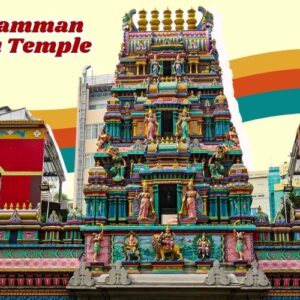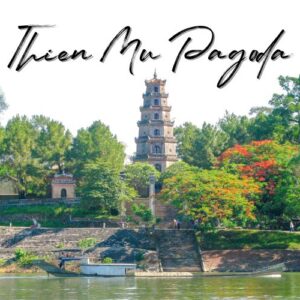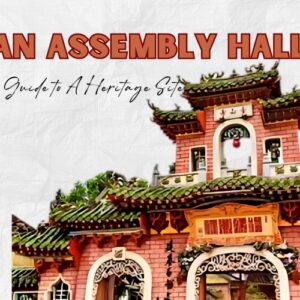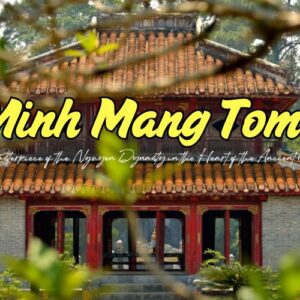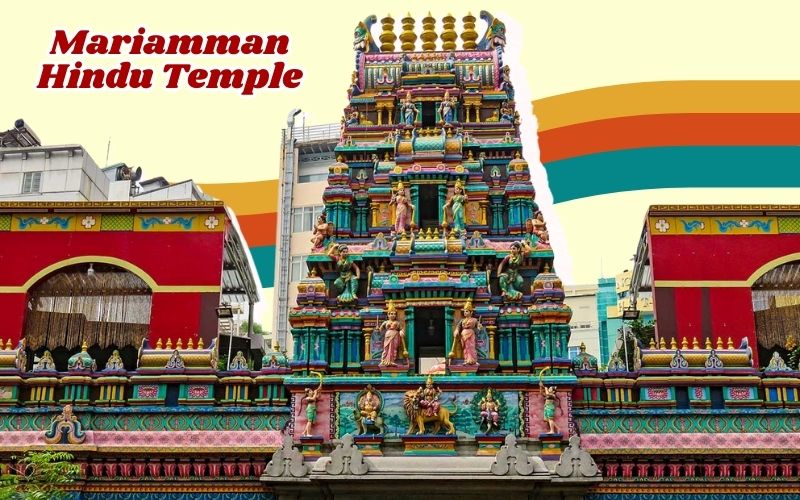
Mariaman Hindu Temple is a peaceful oasis in the heart of Ho Chi Minh City. Founded by Tamil settlers in the early twentieth century, its attractive architecture reflects India’s rich past and Vietnam’s dynamic scenery. This temple is famous for its alleged miraculous abilities, and it is more than just a religious site. Mariamman Hindu Temple serves as a cultural bridge, attracting locals, visitors, and spiritual seekers alike. Diverse influences have enriched Saigon’s cultural fabric over hundreds of years, with this temple serving as a shining example. Do you wish to know about its lovely appearance? Let’s find out in this article below.
Essential Information for Tourists
- Location: 45 Truong Dinh Street, District 1, Ho Chi Minh City
- Opening hours: From 6 am to 8 pm every day, a ceremony and worship will be at 10 am.
- Admission fee: Free
How to get there?
The Marian Hindu Temple has a great location in the heart of Ho Chi Minh City. If you are near Ben Thanh Market, it is only a 250-meter walk to the temple’s entrance. For those who are further away in the city center, it is advisable to hail a cab, which costs an average of 50,000 VND depending on your departure point. IDC Travel offers accessible travel options such as renting a car with a private driver. Our dependable service guarantees that you will travel comfortably and directly to your destination.
Legends and Beliefs of Mariamman Worship
Originating in Tamil state in southern India, Mariamman is the principal god of the Mariamman Hindu Temple in Ho Chi Minh City. Respected in Hinduism, Mariamman is a rain forecaster and a protector of disease, qualities that are highly valuable to the agrarian civilization. Her numerous hands symbolise various forces, while her face and brilliant red clothing encapsulate her essence. She is a powerful presence, whether she is carrying a bowl of rice or a trident tree.
Devotees come to her annually seeking protection against diseases such as chicken pox and measles. Their shield came before the vaccination started. Many are also looking for her blessings on fertility and married harmony.
Considered as Shiva’s avatar, she is the central Hindu figure. Though the rich venerated Shive, Mary Amman gained a particular place in the hearts of underprivileged communities, notably rural farmers.
She also stands for another level of Parvathy, the mother of the cosmos. Respected along with the Lord God Utsapa Amman as “Amman”. Apart from India, his impact reaches Singapore and other countries. But his essence is distinctive in Hindu temples in Amman, Mali, and Ho Chi Minh City.
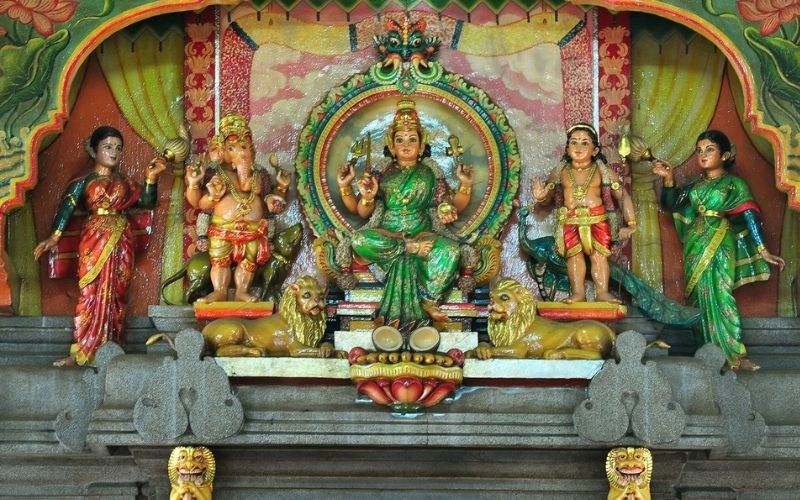
The statue of Mariamman in the main hall
History of Mariamman Hindu Temple
Arrival of the Indian Community
Over 120 years ago, Saigon welcomed Indian groups, primarily Tamils, transported by French colonists from Pondicherry and Karaikal. This hamlet, located near Ben Thanh Market, enhanced Saigon’s cultural tapestry.
Foundations of Faith & Emergence of Temples
The Indian community commenced the construction of temples in Saigon owing to their spiritual affiliation. The Hindu Marian Temple occupies a distinctive place among them. A primitive structure initially designated the site, fulfilling the spiritual requirements of traders and inhabitants. By the conclusion of the 19th century, the architectural marvel emerged, attributed to the efforts of Tamils from Pondicherry and proficient artisans.
Evolution and Rejuvenation
During the 1950s, the Marian Temple experienced substantial renovations with the assistance of Indian businessmen. Following Vietnam’s independence in 1975, the new government instituted administrative arrangements, enabling the First District People’s Committee to oversee its management.
Meaning Today
The Marian Hindu Temple exemplifies the history, resilience, and profound faith of the Indian community in Saigon, providing a representation of Indian culture in the heart of Vietnam.
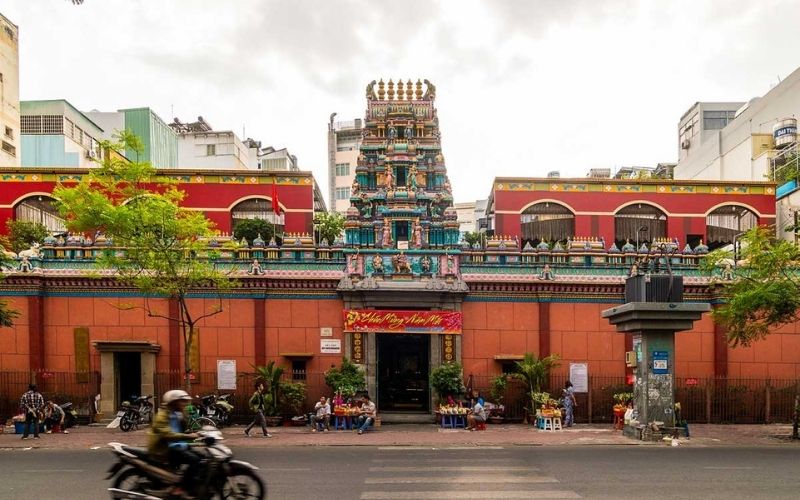
Mariamman Hindu Temple in Ho Chi Minh City
>>> Planning a trip to the bustling Ho Chi Minh City? Reach out to our Historical and Cultural Highlights of Ho Chi Minh City in 5 Days to explore this beautiful in deep.
Features and Architecture of the Hindu Mariamman Temple
Façade and Raja Gopuram
Ho Chi Minh City’s Hindu Mariamman Temple impressively built a vivid external wall covered in arresting orange and scarlet tones. Two temple stories house the main hall and place of worship. The building features two independent entrances facing Truong Dinh Street; the left entrance is smaller than that of peers, thus one needs to exercise extra caution.
A beautiful sight, the 12-meter-high Raja Gopuram sits over the right entrance. Comprising Amman, Luxshimi, Ganesha, and Muruga together with angels and dancers, its intricate sculptures reflect the pantheon of holy beings. A brilliant color palette animates these creatures as well as glittering lions and ornamental lotus flowers.
The strong woman seated between glided lions in the statues of Mariamman on the left and right is waving a trident tree. His blue-dominated clothing, low in pink blossoms, radiates power and authority.
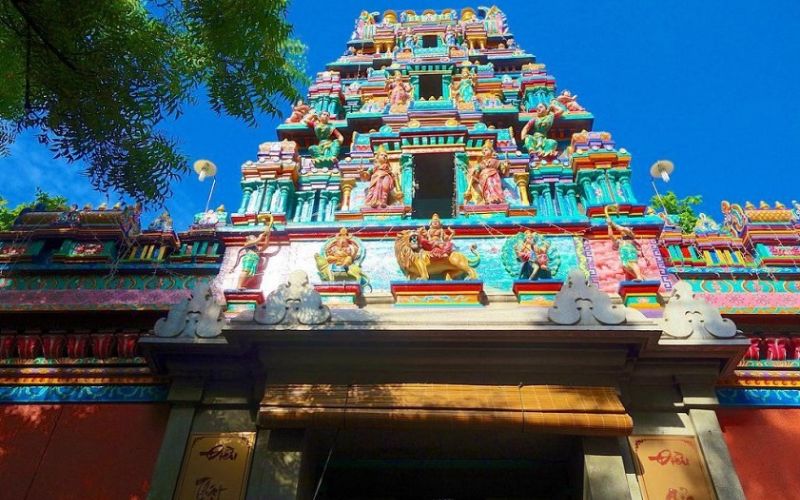
Mariamman Hindu Temple in Ho Chi Minh City
Parallel verses are inscribed on the façade of the temple:
“Kim Thanh Vang Dội Tổng Họa Tài, Diệp Tuyen Dương Nghìn Phúc Lộc”, extolling the virtues of the goodness Mariamman.
“Điều Giả Không Baoo Giờ Tồn Tại, Điều Thật Không Bao Giờ Hủy Hoại”, which means “Falseness never prevails. The truth never perishes.”
Mariamma Shrine
There is a sacred space in the main hall devoted to Mariamman. In Amman, Mali, glistening garlands and necklaces made of grapefruit flowers and other ornaments adorned the sanctuary with black sculptures. In front of the Mariamman statue are two Lingas and Yoni, which represent the inherent power of all people. Further afield, in two glass rooms, you can see statues of revered deities.
The temple and its unique stage are encircled by protective walls. Behold, the devoted genuflects before these fortifications, their heads bowed in reverence. They used special tables for this purpose to place sacrifices.
Several religious sculptures adorn the sanctuary’s roof, adding to its aura of sanctity. Standing tall behind Ganesha and Siddhartha Gautama, Mariamman snatches triplets, a knife, a basin of rice, and a drum encircled by cobras with her four hands. There are sculpted lions, peacocks, dogs, and elephants to round out this holy scene.
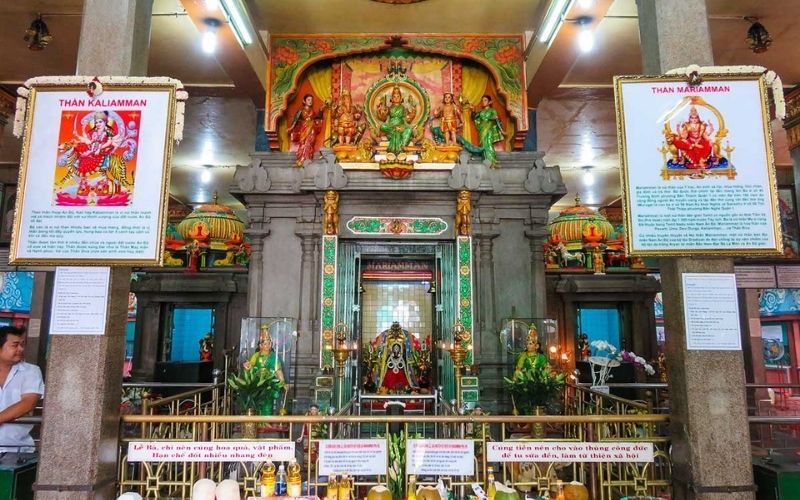
The Mariamman Hindu Temple’s main hall
Maduraiveeran Shrine
God is much worshipped in the temple honoring Maduraiveeran. Rising majestically with many flower garlands and exquisite clothing, an amazing black monument of Manduraivilan Rising from the summit of the temples is a well-made monument of Madurai Velan, accompanied by other holy representatives and two magnificent lions.
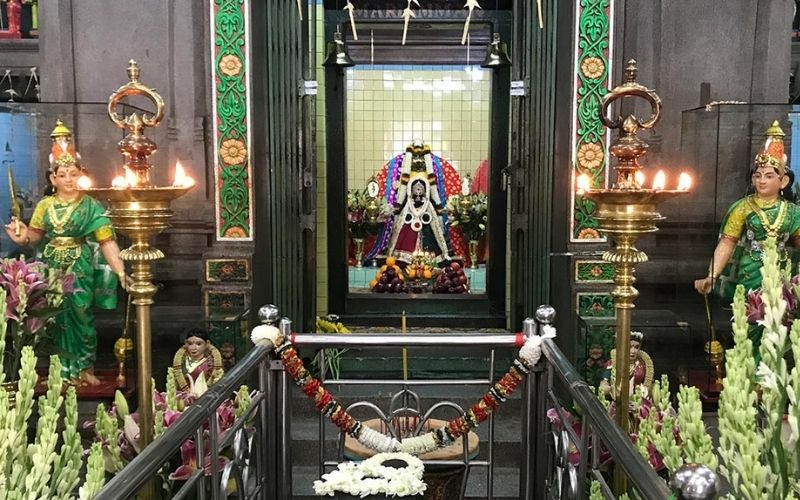
Maduraiveeran Shrine
Pechiamman Shrine
You will be captivated by the Pechiaman statue as soon as you arrive at the shrine. Apart from its rich color tones, this black monument distinguishes itself with its intricately patterned crown. Beautiful wreaths and extravagant ornaments still adorn the crown. Still, your eye should not stop there. Looking at the top of the temple, you will see exquisitely carved sculptures representing the splendor of Pekkaman, flanked by two other respected gods and two magnificent horses. This collection of works shows the respect and commitment toward Pechiaman.
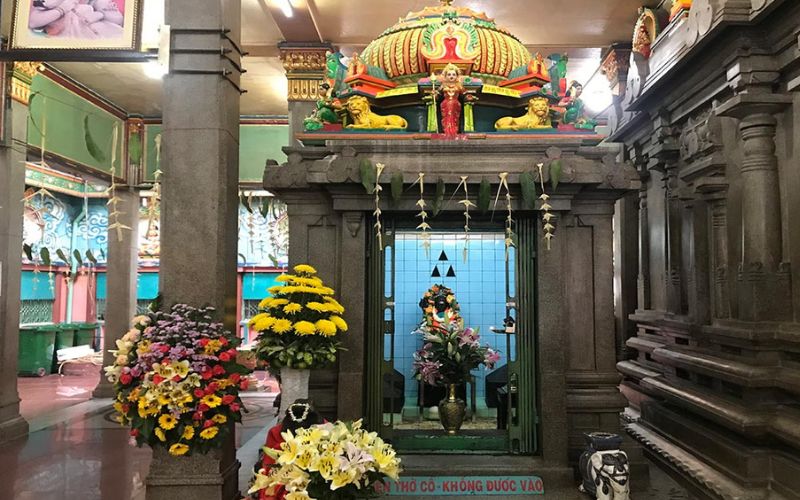
Pechiamman Shrine
Gods and Goddesses on the wall
Surrounding you, on the left, back, and right walls, a stunning collection of 18 statues has been revealed, each depicting Amman and other significant deities in unique forms. These statues are not merely beautiful creations; they represent the 18 aspirations of humanity. This features esteemed individuals including Birmasakthi, Samundi, Bhuvaneswari, Kaliyamman, Meenakshi, Mahavishnu, Andal, Birman, Tirumagal, Mageswari, Indiradurgai, Kamatchiamman, Parvathi et Murugan, Valambigai, Kanniiga Paramiswari, Paramasivam, and Nadarajar. This diverse collection captures the profound beliefs and aspirations that influence human existence.
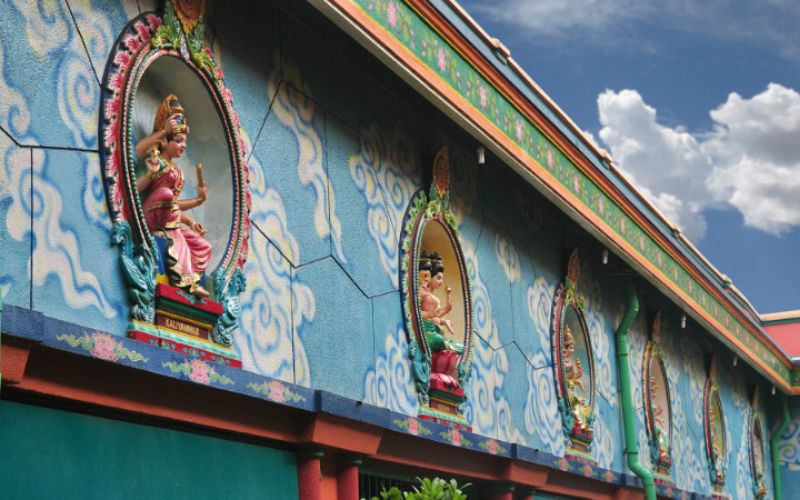
Gods and Goddesses on the wall at Mariamman Hindu Temple
>>> Read our Ho Chi Minh Full Day City Tour for an immersive exploration around highlights of the bustling Ho Chi Minh City.
Mariamman Hindu Temple Office in Ho Chi Minh City
The administrative office of Mariamman Hindu Temple is located on the first floor of Ho Chi Minh City, with convenient transportation. It is worth noting that this temple does not have traditional Hindu or Tamil priests. Its daily activities and rituals are supervised by a board of directors appointed by Vietnamese officials. Two members of the committee of Khmer descent serve as pastors, reciting the Sloka language and practicing Arathi, a practice rooted in a branch of southern Buddhism called Theravada.
The temple has not been granted any official financial assistance. The entirety of its maintenance expenses and charitable initiatives is funded through contributions from its supporters. The temple’s instructions advise against direct monetary donations. People who hold certain beliefs have the option to contribute financially by placing their donations into a charity box. Vibuthi and Prasadam are typically offered as a reciprocal gesture. Given the limited Indian population in this region, a significant number of temple attendees are Vietnamese, Chinese, or from other backgrounds.
Things to Do at Mariamman Hindu Temple
Daily Rituals and Devotions
Every morning at 10 o’clock, the Marian Hindu Temple in Ho Chi Minh City is enveloped in a solemn atmosphere of sacrifice. This traditional sacrifice is intended to invoke goodness favors, regulate the time, and provide good conditions for city dwellers. To add to the ambiance of this solemn event, an ancient bell is delicately hung on the left side of the main entrance, ringing in time with the sacrifice ceremony.
Offerings and acts of devotion
Every day, the temple receives a continuous stream of dedicated visitors, each bearing hope and trust in their hearts. They come with hopes of joy, good health, and success, and they show their devotion through prayers and offerings. The temple altar is frequently adorned with a colorful assortment of floral presents, including lilies, jasmine garlands, and gladioli. In addition to incense, devotees bring rice, sticky rice, salt, sugar, quick noodles, dried mung beans, coconuts, and moss sticks. In a power gesture of devotion, some devotees face them all and express their deepest desires and gratitude to the goodnesses. Furthermore, as a sign of sincere respect and to maintain the sanctity of the hallowed grounds, many visitors remove their shoes before entering the temple grounds.
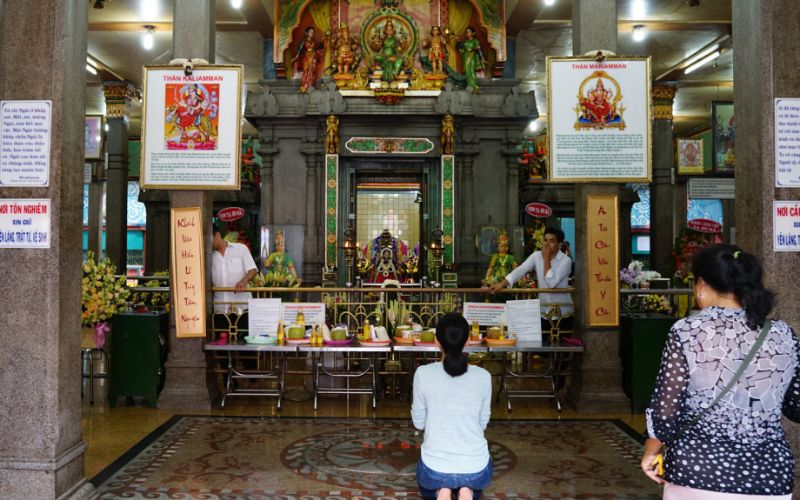
People come to Mariamman Hindu Temple to pray
Charitable initiatives
Aside from being a spiritual haven, the Mariamman Hindu Temple is also noted for its charitable efforts. Over the years, the temple has organized and carried out a variety of charity activities. It offers meals to those who are least fortunate, so while people seek blessings, the temple also contributes to the community’s betterment.
Tips & Rules when visiting Mariamman Hindu Temple in Ho Chi Minh City
Visitors to the temple dress modestly and respectfully. Remember that the temple is open all day on Fridays and the first and fifteenth days of the lunar calendar.
Attention: We invite you to take photographs within the temple to capture your memories. Avoid using flashlights that cause interference. If you wish to film individuals praying, please get their permission first.
A journey to the Hindu Mariamman Temple in Ho Chi Minh City exposes a treasure trove of cultural history and spiritual life. If you want to learn more about Ho Chi Minh City’s tourist attractions and discover the beauty of temples, let us be your compass. Contact us right away, and our expert team will customize the itinerary for you to ensure that you have an unforgettable journey in the heart of Vietnam’s spiritual tradition.
Read more:

